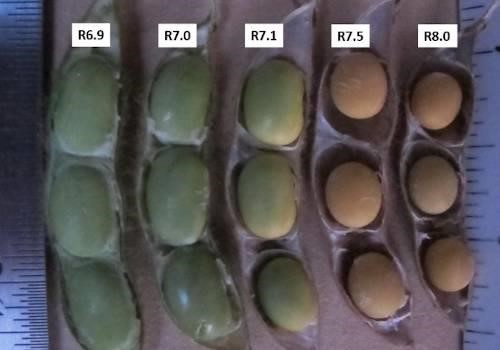By Jim Specht and Jenny Rees
As the heat continues to push crops along, we wished to address some questions we’re receiving regarding ending soybean reproductive stages. The timing of the ending R stages in soybean is governed by planting date (PD) and varietal maturity group (MG), though the date of R7 can be hastened if water stress and high temperatures prevail in August — something we are seeing in portions of Nebraska this year.

Figure 1. Soybean pods collected from stage R7 plants (one mature pod per plant) that were opened to determine if the pod wall interior membrane was still clinging tightly to the seeds (leftmost pod), or if it was beginning to detach from the seeds (second pod), or if the membrane was now permanently attached to the pod wall (third pod). After attaining physiological maturity, seeds undergo a dry-down period from about 60% moisture to about 13% moisture. Note that the Rx.x numbers used here are pod-based stages, not plant-based stages.
One question is regarding final irrigation. An article last week explained how much water is needed to finish soybeans. The questions we’ve received are, “When exactly does physiological maturity occur in soybean” and “How yellow do soybean leaves need to be?” The NebGuide, “Predicting the Last Irrigation of the Season”, speaks to yellowing leaves as the beginning of physiological maturity. Perhaps a better indicator for today’s varieties would be to look at the pods. Until the pods reach R7, physiological maturity, the plant is still utilizing water.
Determining R7 Stage
R7 is defined as the calendar date when 50% (or all) of the field plants possess one mature pod. In many years, most leaves and pods will have changed color (from green to yellow-green or yellow) by this plant-based R7 date. On an individual pod basis, R7 occurs when the pod wall interior membrane ceases to cling tightly to the seeds and instead stays attached to the pod wall (as shown in Figure 1). This pod membrane status is an observable marker of soybean seed physiological maturity (i.e., no further increase in dry matter thereafter), and is effectively equivalent to black layer formation at the base of a corn kernel, a marker of corn seed physiological maturity (Nielsen, 2019).
Soybean stems typically turn brown shortly after R7 begins, though the stem can remain green due for a number of reasons. For a good review of the causes of green stem syndrome, see the article by Jardine, 2020. Still, even then, dry matter gain in the seeds will have already ceased within any pod that has reached R7.
Determining the R8 Stage
The final soybean stage is R8, which occurs when 95% of pods have attained maturity and have a variety-dependent color of brown or tan. Note that the date of the R8 stage is used by soybean breeders to establish/assign an MG number (e.g., 3.1) to each newly released variety. This is based on multi-site-year performance trials in which its R8 maturity date is matched with the R8 date of one of the known maturity-check varieties in those trials.
Seed moisture in a soybean pod undergoes a dry-down phase from about 60% at R7 to about 13% at R8. The rate and duration of this dry-down phase are governed by the daily degree of atmospheric evaporative demand, which is a function of solar radiation, humidity, temperature, wind speed and soil surface moisture. In Iowa State University research studies, the dry-down period averages about 12 days, but can be faster or slower depending on coincident weather (Martinez-Feria et al. 2017).
Source : unl.edu